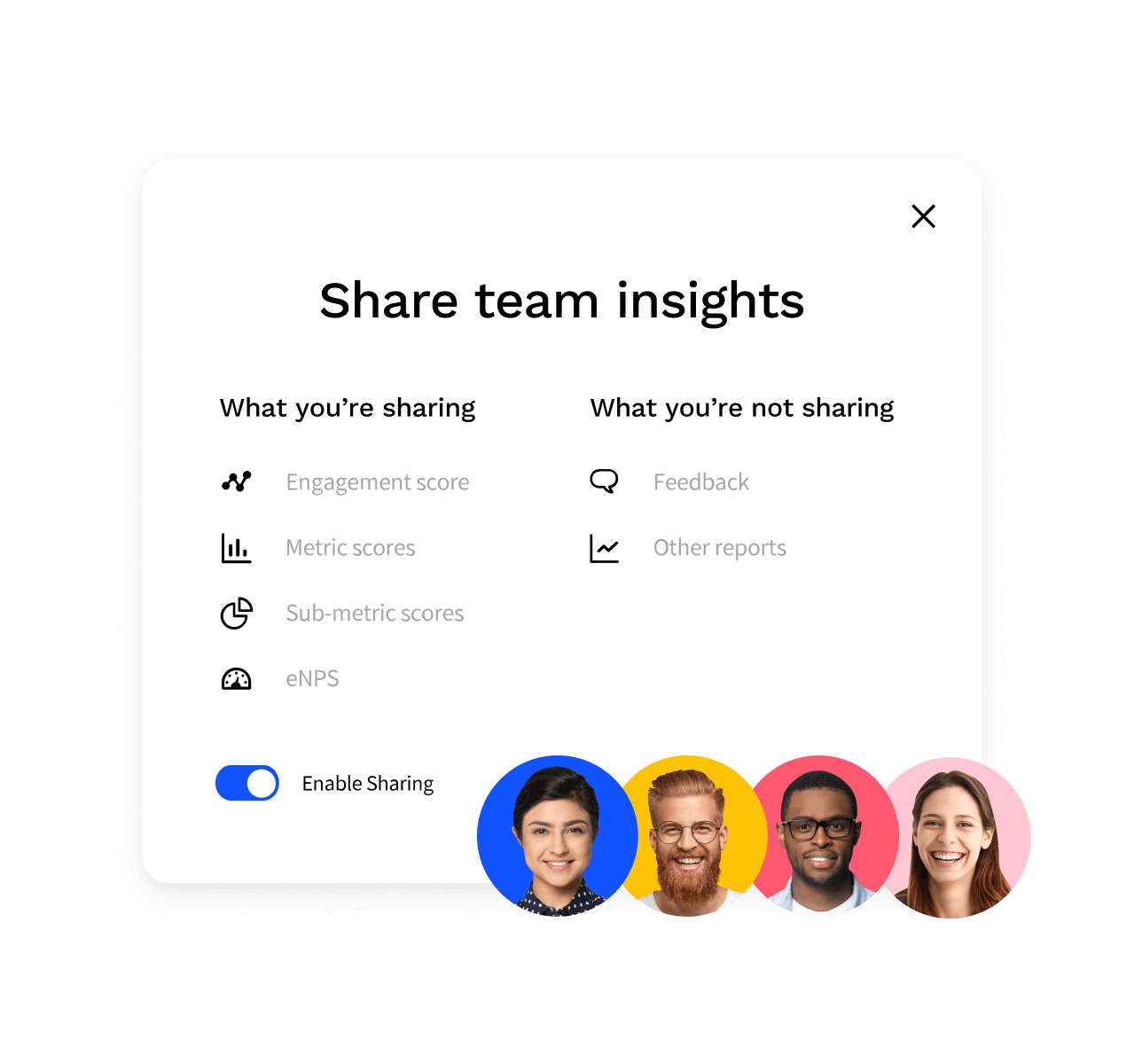With the new reality of increasingly distributed workforces, it’s become more important than ever for managers to check in on their employees with a regular cadence to see how they’re feeling and build strong team relationships.
But despite advances in easy-to-use employee survey software, many companies continue to measure employee engagement solely with sparse quarterly or annual surveys. These infrequent check-ins can open the door for employee disengagement if people don’t feel like they can express their concerns or voice their opinions in a timely manner.
Still, it can be difficult to zero in on the ideal employee engagement survey frequency. Finding that sweet spot between exhaustive data gathering and that one annual survey is the key to getting an authentic read on employee sentiment.
Efficient employee engagement survey practices also give you actionable feedback you can use to measure and improve the employee experience at your organization.
Exclusive online summit
·
May 23 2024
Moments that matter: how to seed great work
What you should know about employee engagement survey frequency:
What’s the ideal frequency of employee engagement surveys?
While there’s no one-size-fits-all strategy for an employee engagement survey cadence, it’s safe to say that you’ll benefit from offering them more than once a year.
The frequency will depend on the survey length and type, what information you want to gather, and what works best for your organization and target audience.
It’s important to note that engagement surveys are an easy tool for collecting feedback, but what matters most is how you take action based on the data you collect. When you conduct a survey, you’ll want to give yourself enough time to:
- Gather feedback
- Analyze responses
- Identify feedback you can act on
- Create action plans
- Carry out those plans
Depending on your workload, it could take weeks or months to carry out your feedback-driven plans. Employees will be more likely to participate in future surveys if they see the company making changes based on their feedback.
To establish the best employee engagement survey frequency for your team, you’ll need to assess your company’s needs and find a rhythm that feels right for your business. Instead of deciding on a survey process for the whole year, you can start with one survey cycle. Once you’ve tackled it from start to finish, you’ll have a better idea of what works and what doesn’t.
Benefits of frequent employee feedback
Conducting frequent surveys can have a significant positive impact on employee engagement and your business. Feedback lets you evaluate employees’ engagement, giving insights into their motivation and commitment. When you make improvements based on employee feedback, it makes them feel heard.
These are a few of the benefits of regularly surveying your team members:
- Improved employee morale
- Reduced turnover
- Increased employee satisfaction
- Higher productivity
According to Officevibe’s Pulse Survey data, 31% of employees wish their managers communicated with them more frequently. Opening a pathway of communication creates a more enjoyable work environment.
Your employees will be happier knowing their opinions matter and that voicing them can enact positive change.
Happy employees are more likely to be satisfied with their job, which leads to lower turnover, higher productivity, and better business performance. Gallup’s workplace research found that companies with higher employee engagement were 23% more profitable.
Employee surveys best practices
If you want to improve employee engagement using regular surveys, you’ll need to optimize more than just the survey cadence. It’s vital to identify the objective of your surveys, create functional questions, and (above all) follow up on the results.
To help make your surveys a success, we’ll share some employee engagement survey best practices.
Ask the right questions
The goal of surveying employees is to get valuable, honest feedback, and the survey questions you ask your team can influence the quality of responses you receive. For example, asking “Do you enjoy your job?” only gets you a “yes” or “no,” which isn’t something you can act on. However, asking “What is one thing you would change about your job?” gives you more to work with.
For longer employee engagement surveys, you might not want to burden your team by asking them to write detailed answers to 100 questions. Instead, ask questions that use a 10-point scale to give you quantifiable data that will measure overall employee engagement.
Get leadership on board
Many organizations leave employee surveys and measuring engagement to their human resource professionals. By removing themselves from the situation, managers lose the opportunity to gain valuable insights into their employees’ experience at work. They can use data from frequent employee engagement surveys to make informed decisions that benefit the whole organization and keep their people motivated.
Getting senior leadership to take part in the process can also improve response rates and increase the chance that the feedback results in positive change.
Follow up surveys with action
If your employees don’t notice improvement after taking their time to give feedback in a survey, they’ll feel discouraged about participating in the future. Once you’ve surveyed your team, it’s time to track progress and formulate a plan using specific feedback from your research.
This step might include working with other leaders to determine changes to the workplace, policies, or business strategy. As long as you act on the employee survey results, your employees will be more likely to get on board with the survey frequency.
Share results and action plans
An essential component of maintaining transparency with your employees is to communicate the actions you intend to take based on your survey results.
They don’t have the same bird’s-eye perspective as you, so they might not be aware when you make a change in response to their concerns.
You can involve your team in the process by presenting survey findings in a meeting, presentation, or email (along with your action plan). Open communication channels will show your team that they’re an integral part of the organization.

Make the surveys anonymous
It’s essential to protect your employees’ privacy when conducting an employee survey. When the survey questions are anonymous, they’re more likely to give honest feedback. Officevibe’s Pulse Surveys are anonymous by default, so employees can feel safe expressing themselves, and leaders can gain more valuable data.
Combatting employee engagement survey fatigue
Many organizations opt for annual employee surveys to avoid survey fatigue, but this infrequency may be counterproductive. If your annual survey process involves 150 questions about every aspect of the workplace, employees may groan at the thought of taking a survey more than once a year.
By using short Pulse Surveys, you can reduce survey fatigue. Leave the lengthy questionnaires for yearly or quarterly reviews. A weekly or monthly Pulse Survey can give you quick insights into the status of your employee engagement.
Tip: Ask questions that are easier to answer so your employees don’t give up halfway through. Better yet, use a dedicated pulse survey software that does the heavy lifting for you.
What is the frequency of Officevibe’s Pulse Surveys, and why?
Officevibe’s Pulse Surveys ask employees five questions per week using an intuitive algorithm that sends specific questions related to employee engagement.
Managers can use their findings to spot where employees need support or where there’s room for improvement in the company.
Unlike annual employee surveys, Pulse Surveys get real-time feedback for relevant insights on how your team is doing.
Officevibe’s employee engagement software replaces paper surveys, allowing your team members to remain anonymous when giving feedback in a more sustainable way. Anonymity gives your employees the confidence to respond to an employee survey honestly without fear of repercussion.
Frequent surveys lead to success
Higher survey cadences can help you keep tabs on the impact of your organization’s changes through frequent employee feedback, leading to more successful business outcomes and quicker responses when challenges arise.
Officevibe provides effective change initiatives and solutions for leaders who want to tap into employee experience in their organizations. Our Pulse Survey tool allows you to send a short employee engagement survey weekly or monthly, helping you make data-driven decisions based on easy-to-read reports.
Give a voice to employees and learn how listening to employee feedback can foster a collaborative, transparent, and motivated work environment.
Equip HR and managers with tools to engage, recognize, and drive performance.




